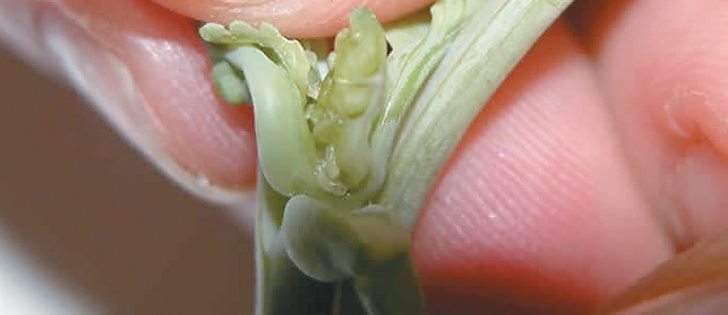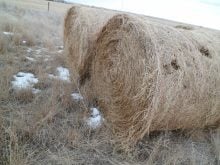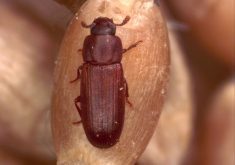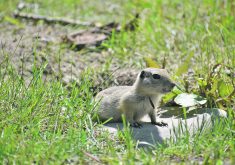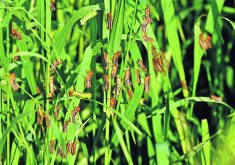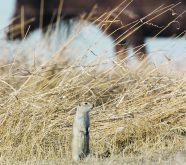Swede midge pressure in northeastern Ontario has cut into canola acreage — the province once had up to 80,000 acres but this year it’s less than 30,000
Farmers in northeastern Ontario made a wise choice when they decided to stop growing canola this year, says the president of the Ontario Canola Growers Association.
That’s because Swede midge pressure is higher than ever in the region.
An association field agent found hundreds of Swede midge flies in pheremone traps during the second week of June near Temiskaming, Ont.
“There were like 800 plus (per trap). The threshold is four,” said Terry Phillips, who farms near New Liskeard, Ont., where Swede midge has devastated canola yields over the last few years.
Read Also

Saskatchewan dairy farm breeds international champion
A Saskatchewan bred cow made history at the 2025 World Dairy Expo in Madison, Wisconsin, when she was named grand champion in the five-year-old Holstein class.
The association’s newsletter advised farmers in the Temiskaming region in January to stop growing canola for three years because Swede midge populations were out of control.
“Currently, huge numbers of adult Swede midge emerge from soil pupae in the spring … (and) overwhelm young canola plants in neighbouring fields throughout Temiskaming,” the association said.
“Considering the disappointing average yields of well below one tonne per acre in 2013 and 2014 (and) the overwhelming number of pupae now present in soils … the strategy being encouraged by OCGA … is a moratorium on canola production in Temiskaming for three years.”
Swede midge lay eggs in the growing point of canola plants, and the larvae hatch a few days later.
According to the Ontario agriculture ministry website, the larvae feed on the canola, and that “changes the physiology of the plant and results in the formation of swollen, distorted and twisted tissue.”
It’s difficult to control the insect and larvae with insecticides. Four to five generations of Swede midge can be produced in Ontario during the growing season.
Many growers in the Temiskaming region are adhering to the moratorium. Canola acreage in the area, which is near the Quebec border, has dropped from 30,000 a few years ago to almost nothing.
“Now we’re down to maybe a couple of thousand acres,” Phillips said.
Growers have switched to other crops. For example, Philips is growing flax and faba beans for the first time.
“My brother kind of jokes (that) our farm is like an experimental farm.”
Flax is now a realistic option because a pilot project allows Ontario growers to receive crop insurance for the oilseed.
“Guys have been growing flax, but it was always a tough crop because there was no crop insurance available,” Phillips said.
The extreme Swede midge pressure in northeastern Ontario has cut into canola acreage across the province. Ontario once had 70,000 to 80,000 acres of canola, but this year it’s 25,000 to 30,000 acres.
Swede midge has been detected on canola fields in southern and central Ontario, but for unknown reasons the population doesn’t explode like it does in the Temiskaming region.
Brian Hall, a canola specialist with the provincial agriculture ministry, said Swede midge is only partly responsible for the acreage drop.
The other factor is soybeans.
“For other growers … their decision was a lot based on the economics of canola this year,” he said.
“I think it was the economics of canola versus soybeans.”
Canola is more difficult and costly to grow than soybeans. Canola producers have to pay for nitrogen fertilizer and manage aggravating pests such as flea beetles.
Phillips said canola still has a future in the province.
Crops such as flax and faba beans are intriguing, but marketing canola is easy in Ontario.
“You truck it to Hamilton and you can pre-sell,” he said.
“There are a lot of pluses to canola that these other crops don’t have.”
As well, Phillips said some farmers like to have canola in their rotation because it’s harvested almost a month before soybeans, which makes it a good fit with winter wheat.
Hall said canola is an excellent rotation crop, boosting soybean yields when included in a corn-soybean rotation.
“We know that there is a yield advantage from having a three crop rotation versus running two crops,” he said.
“Having more crops in the rotation is positive in terms of yield and pest control.”
Still, farmers and agronomists will have to find solutions to the Swede midge problem before canola truly rebounds in Ontario, Hall said.
Phillips said Bayer Crop Science is working on a systemic insecticide that could kill midges and the larvae.
However, commercialization of such a product remains uncertain.


